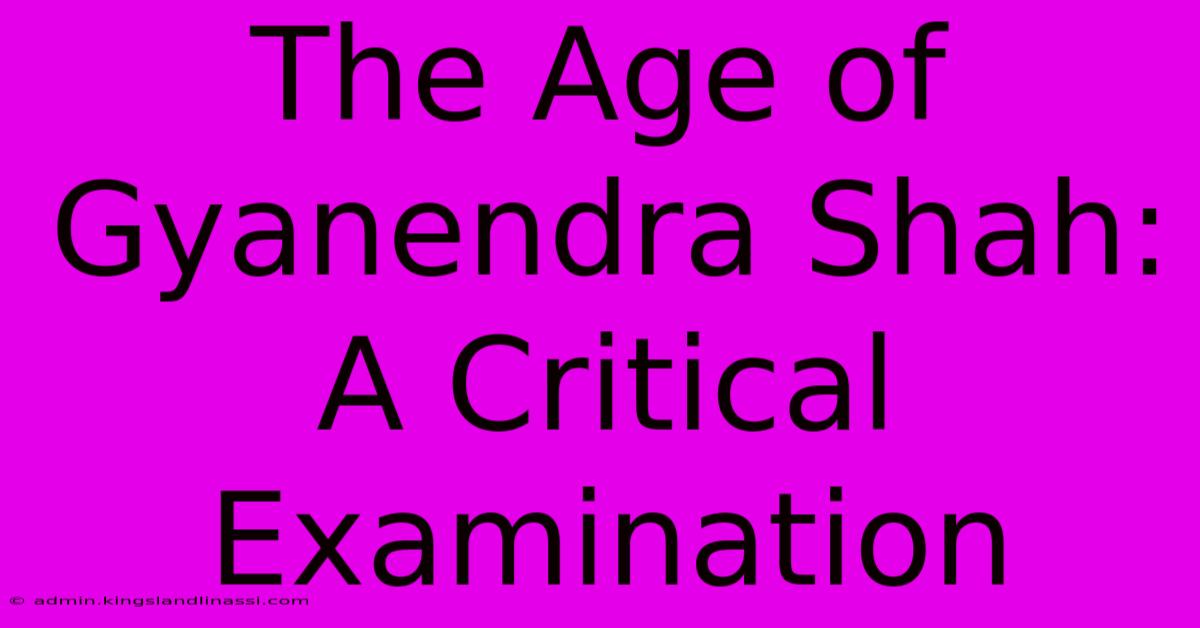The Age Of Gyanendra Shah: A Critical Examination

Table of Contents
The Age of Gyanendra Shah: A Critical Examination
King Gyanendra's reign in Nepal, from 2001 to 2008, remains a controversial and pivotal period in the nation's history. This era, often characterized by political upheaval, human rights violations, and ultimately, the end of the monarchy, demands a critical examination. This article will delve into the key events, controversies, and lasting legacies of Gyanendra Shah's rule.
The Ascent to Power and Early Reign
Gyanendra's ascension to the throne followed the infamous royal massacre of June 1, 2001, where Crown Prince Dipendra murdered most of the royal family, including King Birendra. This tragic event plunged Nepal into uncertainty, leaving Gyanendra to assume the kingship amidst national mourning and political instability. Initially, his reign saw a continuation of the existing political landscape, characterized by a fragile peace between the government and the burgeoning Maoist insurgency.
The Growing Power of the Maoists
The Maoist insurgency, led by Pushpa Kamal Dahal "Prachanda," gained significant momentum throughout the early 2000s. Their rural-based guerrilla warfare challenged the government's authority and destabilized the nation. Gyanendra's initial attempts to address the conflict were largely ineffective, and the situation continued to deteriorate. This escalating violence fueled public discontent and fueled calls for political reform.
The Royal Takeover and its Consequences
In 2005, citing the government's inability to control the Maoist insurgency, King Gyanendra seized absolute power, dismissing the elected government and suspending fundamental rights. This controversial move marked a significant turning point, triggering widespread protests and international condemnation.
Human Rights Abuses and Repression
The period of royal rule witnessed a significant crackdown on dissent. Journalists, human rights activists, and political opponents faced arrest, detention, and even torture. Freedom of speech and assembly were severely curtailed, creating an atmosphere of fear and repression throughout the country. These actions eroded public trust and further alienated the King from the population.
International Condemnation and Isolation
Gyanendra's actions garnered widespread international criticism. Many countries condemned the human rights abuses and called for the restoration of democracy. This international pressure, coupled with the growing domestic opposition, further weakened the king's position.
The Movement for Democracy and the End of the Monarchy
The Nepali people, galvanized by the repression and yearning for democracy, launched widespread protests against the king's rule. These demonstrations, often met with brutal force, eventually coalesced into a powerful movement demanding the restoration of democracy and an end to the monarchy. This movement, involving a broad spectrum of political parties and civil society organizations, proved to be instrumental in forcing Gyanendra to relinquish power.
The 2006 People's Movement and its Aftermath
The April 2006 People's Movement, a coordinated effort by pro-democracy forces, played a crucial role in ending Gyanendra's absolute rule. The movement, marked by widespread strikes and protests, ultimately forced the king to reinstate the parliament and cede his executive powers. This marked a significant victory for the pro-democracy movement and paved the way for the eventual abolition of the monarchy.
The Legacy of Gyanendra's Reign
Gyanendra Shah's reign remains a deeply divisive period in Nepali history. While some may view his actions as necessary to combat the Maoist insurgency, his seizure of absolute power and subsequent human rights abuses are widely condemned. The legacy of his rule is one of political instability, human rights violations, and ultimately, the end of the centuries-old Nepali monarchy. The events of this period serve as a cautionary tale about the dangers of unchecked power and the importance of democratic principles and human rights.
Keywords: Gyanendra Shah, Nepal, Monarchy, Royal Massacre, Maoist Insurgency, People's Movement, Democracy, Human Rights, Political Upheaval, Royal Takeover, Absolute Rule, 2006 Revolution
This article aims to provide a balanced and critical examination of Gyanendra Shah's reign, using factual information and avoiding biased language. Further research and exploration are encouraged for a deeper understanding of this complex historical period.

Thank you for visiting our website wich cover about The Age Of Gyanendra Shah: A Critical Examination. We hope the information provided has been useful to you. Feel free to contact us if you have any questions or need further assistance. See you next time and dont miss to bookmark.
Featured Posts
-
Whozu Age The Simple Habits Of Ageless People
Apr 21, 2025
-
The Family Secret My Best Friends Son
Apr 21, 2025
-
Lil Yachtys Daughter A Fathers Pride
Apr 21, 2025
-
Chebukatis Daughter An Icon In The Making
Apr 21, 2025
-
Prodigal Son Meaning Inspiring Stories Of Redemption
Apr 21, 2025
